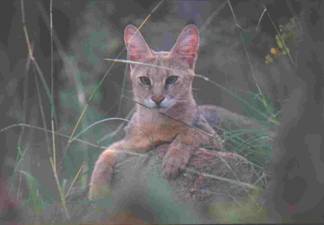Understand The Animals
 Dr. Shomita worked at the Wildlife Trust of India, Delhi and Tiger Watch, Ranthambhor. She is writing a proposal that aims to explore the utility of non-invasive DNA analysis in addressing questions related to small carnivore
ecology. Though her chief interest lies in the ecology of small cats, she is also planning a project on the leopards of Sanjay Gandhi National Park in Mumbai along with some other friends. Currently employed with the Centre for Wildlife Studies, Bangalore. Dr. Shomita worked at the Wildlife Trust of India, Delhi and Tiger Watch, Ranthambhor. She is writing a proposal that aims to explore the utility of non-invasive DNA analysis in addressing questions related to small carnivore
ecology. Though her chief interest lies in the ecology of small cats, she is also planning a project on the leopards of Sanjay Gandhi National Park in Mumbai along with some other friends. Currently employed with the Centre for Wildlife Studies, Bangalore.
|
The winter of January 1995 in Sariska Tiger Reserve, Rajasthan was particularly cold. I had to gather all my courage and venture out in the blood-freezing cold to study jungle cats (Felis chaus
) and caracal ( Caracal caracal ) for my Ph.D. The climate was the only drawback there, with freezer-cold winters and roasting summers. The rest was a joy since I saw jungle cats more closely than I ever imagined I could. This particular night
I was out on my prowl looking for cats while they were prowling around for their meal. Suddenly there was a loud sharp bark and dramatically my vehicle stalled just then, close to where the sound emanated from. The silence of the night after that loud sound
became more noticeable, till another loud bark shattered it. I jumped off the vehicle along with my assistants and driver hoping to see a leopard or some large carnivore in thenullah
below. To our surprise it was none other than the 4kg jungle cat that inhabits almost all habitats in our country. I had never known till then that jungle cats bark. Later when I was raising 2 jungle cat kittens I realized that this was just one of their
several calls. They could put the largest dog to shame with their loud barks! They also mewed and purred like house cats.
 They look like typical cats but have large ears tipped black with little tufts, long slender legs and a short tail. They are ruddy brown to pale sandy and sometimes almost black in colour depending on the region where they occur.
They have prominent white cheeks and grass-green eyes. This cat is very dependent on water and though it lives in relatively dry areas, water is its primary requirement. Little wonder that this species does well in irrigated agricultural fields. However, it
is not known how well their kittens survive to adulthood in these crop fields because often harvest times coincide with their breeding and many kittens must be lost then. Moreover, thousands are poached illegally for their pelt. Despite having a wide distribution
spanning from Egypt to Vietnam , very little is known about this cat. They probably do us a great favor by keeping rodent numbers low in crop fields since my study showed that each jungle cat in Sariska ate around 1500 rodents per year! The least we can do
in return is help this beautiful cat continue to survive. . They look like typical cats but have large ears tipped black with little tufts, long slender legs and a short tail. They are ruddy brown to pale sandy and sometimes almost black in colour depending on the region where they occur.
They have prominent white cheeks and grass-green eyes. This cat is very dependent on water and though it lives in relatively dry areas, water is its primary requirement. Little wonder that this species does well in irrigated agricultural fields. However, it
is not known how well their kittens survive to adulthood in these crop fields because often harvest times coincide with their breeding and many kittens must be lost then. Moreover, thousands are poached illegally for their pelt. Despite having a wide distribution
spanning from Egypt to Vietnam , very little is known about this cat. They probably do us a great favor by keeping rodent numbers low in crop fields since my study showed that each jungle cat in Sariska ate around 1500 rodents per year! The least we can do
in return is help this beautiful cat continue to survive. .
(Photograph of jungle cat- Krupakar Senani)
|